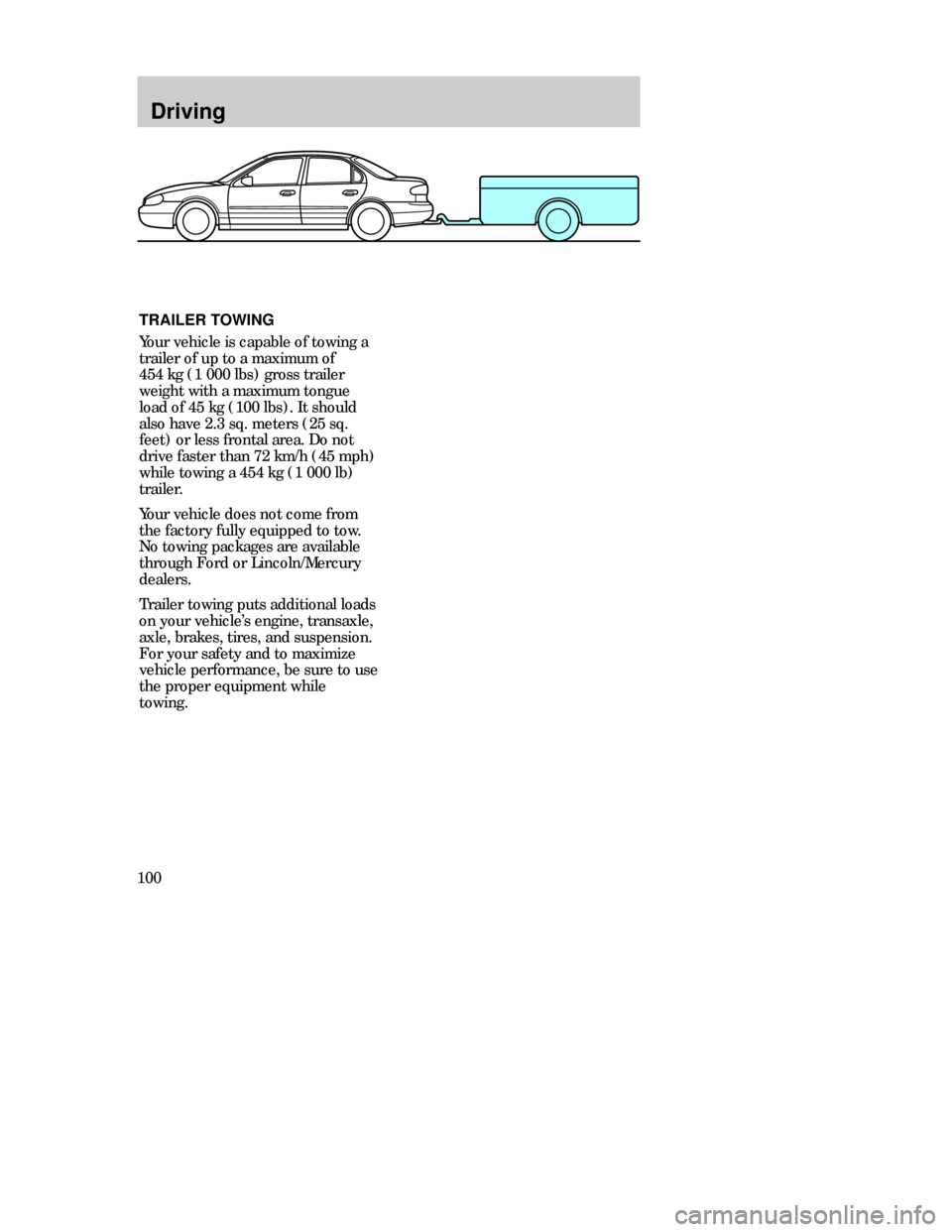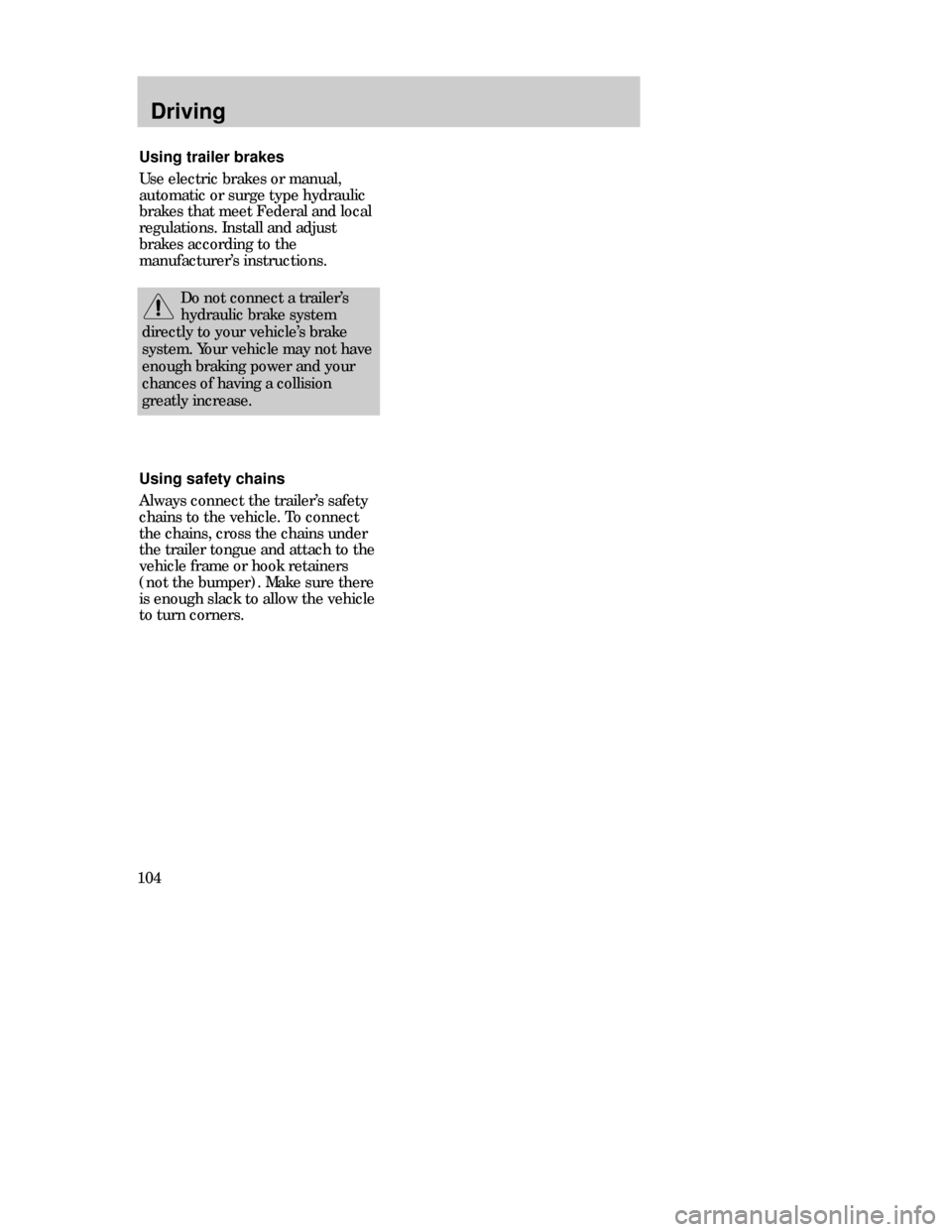brake Mercury Mystique 1998 s Owner's Guide
[x] Cancel search | Manufacturer: MERCURY, Model Year: 1998, Model line: Mystique, Model: Mercury Mystique 1998Pages: 196, PDF Size: 1.65 MB
Page 89 of 196

Driving
89 The console-mounted gearshift will
lock when you turn the key to the
lock position. When the gearshift is
in any position except P (Park),
the ignition key cannot be turned
to lock or removed from the
steering column. To remove the
key, the gearshift lever must be in
P (Park).
Once the gearshift is secure in the
desired position, release the brake
pedal and use the accelerator as
necessary.
Driving
Never leave a vehicle
unattended while it is
running.
•P(Park)
Always come to a complete stop
before shifting into P (Park). This
locks the transaxle and prevents
the front wheels from rotating.
•R(Reverse)
The vehicle only moves backward.
Always come to a complete stop
before shifting in or out of R
(Reverse).P=Park. . . . . . . . . . . . . .
R=Reverse. . . . . . . . . . .
N=Neutral. . . . . . . . . . . .
D=Drive: Gear 1 to 4
with overdrive. . . . . .
Gear 1 to 3
with overdrive
cancelled. . . . . . . . . .
2=Gear 2. . . . . . . . . . . .
1=Gear 1. . . . . . . . . . . .
CDW IVB1-10Driving en MM 5/15/97 7:51 PM Page 89
Page 90 of 196

Driving
90
•D (Overdrive)
Note that the vehicle’s gearshift is
console-mounted on the floor. The
transaxle control switch (TCS) is
located on the gearshift handle.
The transaxle control indicator
light (O/D light) is located on the
instrument panel.
Overdrive is not shown on the
display, but is the default mode for
the D gearshift position. This is the
normal driving mode for the best
fuel economy. The transaxle
operates in gears one through four.
The O/D light is off (not
illuminated) during normal vehicle
operation.
Overdrive can be deactivated by
pressing the transaxle control
switch (TCS) located on the
gearshift handle. The O/D OFF
indicator light will illuminate in the
instrument cluster.
•N(Neutral)
The wheels of the transaxle are not
locked. Your vehicle will roll freely,
even on the slightest incline, unless
the parking brake or brakes are on.
CDW IVB1-10Driving en MM 5/15/97 7:51 PM Page 90
Page 93 of 196

Driving
93 Manual transaxle (if equipped)
Vehicles equipped with a manual
transaxle have a starter interlock
that prevents cranking the engine
unless the clutch pedal is fully
depressed.
Using the clutch
When starting a vehicle with a
manual transaxle:
1. Hold down the brake pedal.
2. Depress the clutch pedal.
3. Put the gearshift lever in neutral.
4. Start the vehicle.
5. Put the gearshift in 1 (First) or R
(Reverse).
6. Release the clutch slowly while
pressing gradually down on the
accelerator pedal.
Do not drive with your foot resting
on the clutch pedal. Do not use the
clutch to hold your vehicle at a
standstill while waiting on a hill.
These actions may reduce the
clutch life.
CDW IVB1-10Driving en MM 5/15/97 7:51 PM Page 93
Page 95 of 196

Driving
95
Parking
1. Apply the brake and the clutch
and shift into neutral.
2. Engage the parking brake.
3. Shift into 1 (First) or R
(Reverse).
4. Turn the ignition off.
Do not park your vehicle in
Neutral, it may move
unexpectedly and injure someone.
Use 1 (first) gear and set the
parking brake.
Reverse
To shift into R (Reverse):
1. Completely stop your vehicle.
2. Depress the clutch pedal to the
floor and place the gearshift lever
in the neutral position. Do not
release the clutch pedal.
3. If the following direction is not
followed, a grinding noise may
occur.
Wait a miminum of three seconds
before attempting to shift into R
(Reverse) gear.
4. Push the gearshift lever
completely to the right, pull up the
ring on the stalk of the gearshift
lever, and then pull rearward on
the gearshift lever to engage the R
(Reverse) gear.
5. If the R (Reverse) gear is
engaged, slowly release the clutch
pedal from the floor.
1
2
CDW IVB1-10Driving en MM 5/15/97 7:51 PM Page 95
Page 100 of 196

Driving
100TRAILER TOWING
Your vehicle is capable of towing a
trailer of up to a maximum of
454kg (1000 lbs) gross trailer
weight with a maximum tongue
load of 45kg (100 lbs). It should
also have 2.3sq. meters (25sq.
feet) or less frontal area. Do not
drive faster than 72km/h (45mph)
while towing a 454kg (1000lb)
trailer.
Your vehicle does not come from
the factory fully equipped to tow.
No towing packages are available
through Ford or Lincoln/Mercury
dealers.
Trailer towing puts additional loads
on your vehicle’s engine, transaxle,
axle, brakes, tires, and suspension.
For your safety and to maximize
vehicle performance, be sure to use
the proper equipment while
towing.
CDW IVB1-10Driving en MM 5/15/97 7:51 PM Page 100
Page 104 of 196

Driving
104Using safety chains
Always connect the trailer’s safety
chains to the vehicle. To connect
the chains, cross the chains under
the trailer tongue and attach to the
vehicle frame or hook retainers
(not the bumper). Make sure there
is enough slack to allow the vehicle
to turn corners.
Do not connect a trailer’s
hydraulic brake system
directly to your vehicle’s brake
system. Your vehicle may not have
enough braking power and your
chances of having a collision
greatly increase.
Using trailer brakes
Use electric brakes or manual,
automatic or surge type hydraulic
brakes that meet Federal and local
regulations. Install and adjust
brakes according to the
manufacturer’s instructions.
CDW IVB1-10Driving en MM 5/15/97 7:51 PM Page 104
Page 105 of 196

Driving
105 Driving while towing a trailer
Do not drive faster than 72km/h
(45mph) while towing a 454 kg
(1000lb) trailer. Do not drive
faster than 72km/h (45mph) with
any weight trailer while towing in
hilly terrain or on hot days.
Speed control (if equipped) may
not work properly while towing on
long, steep grades.
If driving with an automatic
transaxle:
•Use D (Drive) or a low gear
rather than D (Overdrive) while
towing up or down steep inclines.
•Anticipate stops and brake
gradually.
If driving with a manual transaxle:
•Select a gear that avoids jerking
or excessive engine speed.
•Avoid driving excessively in first
or second gear. If you need to
drive excessively in first or
second gear, the trailer may be
too big or too heavily loaded for
the vehicle drivetrain.
•Shift to a lower gear while towing
up or down steep hills.
•Anticipate stops and brake
gradually.
CDW IVB1-10Driving en MM 5/15/97 7:51 PM Page 105
Page 106 of 196

Driving
106FUELCONSUMPTION
Fuel economy can be improved by
avoiding:
•lack of regular, scheduled
maintenance,
•excessive speed,
•rapid acceleration,
•driving with the brake pedal
depressed,
•sudden stops,
•extended engine idling,
•use of speed control in hilly
terrain,
•extended use of the air
conditioner, defroster, rear
window defroster and other
accessories,
•underinflated tires,
•heavy loads,
•aftermarked add-ons such as
bike, ski or luggage racks, bug
deflectors, etc.
CDW IVC1-6Roads en MM 5/15/97 7:53 PM Page 106
Page 114 of 196

Roadside emergencies
114
Passenger compartment fuse panel (below instrument panel)
FuseAmpere
ratingColorCircuits protected
19
20
21
22
23
24
25
26
27
28
29
30
31
32
33
34
35
36
37
38—
C10
40
7.5
15
15
20
7.5
15
30
30
7.5
7.5
7.5
7.5
7.5
7.5
10
30
——
black
orange
brown
light blue
light blue
yellow
brown
light blue
light green
light green
brown
brown
brown
brown
brown
brown
red
light green
–Not used
Wiper motors (circuit breaker)
Power windows
ABS module
Backup lamps
Brake lamps
Door locks
Main light
Cigar lighter
Electric seats
Rear window defrost
Engine management system
Instrument panel illumination
Radio
Parking lamps - driver’s side
Interior lighting/electric mirror
adjustment/clock
Parking lamps - passenger’s side
Air bag
Heater blower motor
Not used
CDW IVC1-6Roads en MM 5/15/97 7:53 PM Page 114
Page 116 of 196

Roadside emergencies
116
CHANGING TIRES
Park your vehicle in such a position
that neither the traffic nor you are
hindered or endangered when
changing the tire. Ensure that the
vehicle is on firm, level ground. If
necessary, secure your vehicle
further by blocking the wheels with
chocks.
Activate the hazard lights.
Apply the parking brake and
engage first or reverse gear or, if
the vehicle has an automatic
transaxle, select the P (Park)
position.
If parking on a slope is unavoidable,
secure the wheels with suitable
chocks.
CDW IVC1-6Roads en MM 5/15/97 7:53 PM Page 116